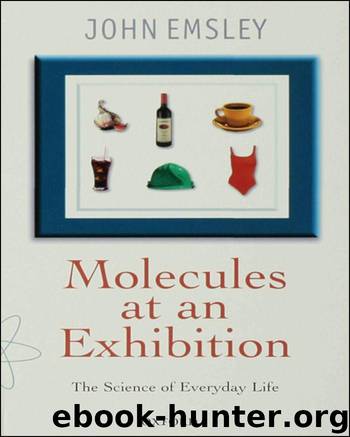Molecules at an Exhibition by John Emsley

Author:John Emsley
Language: eng
Format: mobi
ISBN: 9780191026294
Publisher: Oxford University Press, USA
Published: 0101-01-01T00:00:00+00:00
Portrait 2
Plastic dickies and exploding balls—celluloid
Modern plastics are so strong, so versatile, so safe, so dull—which may be why the public finds them rather boring. How different was the first successful plastic, celluloid. Rayon may have been redeemed as Tencel; but celluloid, the old type of plastic which was made from cellulose, will probably never return to its former popularity, though it is still has its niche uses. It is mainly cellulose nitrate, and though it is highly flammable, it is still used to make table tennis balls and nail varnish, which are rarely a cause for alarm.
People were fascinated by celluloid when it first appeared in the 1860s, and by the many guises in which they encountered it, as buttons and billiard balls, trinket boxes and toys, collars and dickies—those uncontrollable false shirt fronts that featured in early comedy films. Celluloid was welcomed as part of a new age of chemistry. It was cheaper than ivory, the material it was mainly replacing, and demand for which could only be satisfied by the slaughter of 20 000 elephants a year. Admittedly celluloid was dangerously flammable, and at times it could even be explosive. There were tales of celluloid billiard balls colliding so violently that they went off with a bang. When this happened in a saloon in Colorado it started a gunfight … or so said John Wesley Hyatt, the man who popularized celluloid, in his 1914 acceptance speech for the Perkin Medal, which he was awarded by the London Chemical Society, now the Royal Society of Chemistry. By then celluloid had been on the market for almost 50 years, and many thought Hyatt had even invented it.
The story of celluloid began in 1845, when the Swiss German chemist Christian Schönbein reacted cotton with a mixture of concentrated sulphuric acid and nitric acid. The resulting material was cellulose nitrate, and it had a rather remarkable property. When compressed into blocks it was extremely explosive, and this became one of its major uses as gun cotton or nitrocellulose.
Depending on the conditions and the extent of nitration, the product could vary from a plasticine-like solid to a viscous liquid. The explosive version had three nitrate groups attached to each glucose ring, but if nitration was limited to two groups, then the product did not explode, although it was still highly flammable. This form of cellulose nitrate reached the public in two forms: collodion and celluloid. Collodion was a solution of cellulose nitrate dissolved in a 50/50 mixture of alcohol and ether (these solvents are more correctly called ethanol and diethyl ether), and was the basis of fast-drying enamel paints. It was eagerly bought by youngsters as an adhesive for model building, while their parents kept a small bottle in the medicine cabinet and used it to remove painful corns from their toes. Celluloid was a plastic version of cellulose nitrate formulated with about 20% camphor, which is a waxy solid obtained originally by distilling the bark of the camphor tree which grows in Japan.
Download
This site does not store any files on its server. We only index and link to content provided by other sites. Please contact the content providers to delete copyright contents if any and email us, we'll remove relevant links or contents immediately.
500 AP Chemistry Questions to Know by Test Day(1212)
MCAT General Chemistry Review 2019-2020 by Kaplan Test Prep(1147)
The Great Mental Models Volume 2 by Shane Parrish(1099)
500 AP Chemistry Questions to Know by Test Day by Mina Lebitz(1059)
5 Steps to a 5 by John T. Moore(990)
Rules for Writers by Diana Hacker & Nancy Sommers(875)
MCAT General Chemistry Review by Princeton Review(845)
Cracking the SAT Chemistry Subject Test, 1 by Princeton Review(823)
Ingredients by George Zaidan(762)
The MCAT Chemistry Book by Aryangat Ajikumar(726)
A Rulebook for Arguments by Weston Anthony;(699)
MCAT Organic Chemistry Review by Princeton Review(679)
MCAT General Chemistry Review 2020-2021 by Kaplan Test Prep(607)
Kaplan MCAT General Chemistry Review: Created for MCAT 2015 (Kaplan Test Prep) by Kaplan(587)
5 Steps to a 5 by Mina Lebitz(585)
The Elements We Live By: How Iron Helps Us Breathe, Potassium Lets Us See, and Other Surprising Superpowers of the Periodic Table by Anja Røyne(560)
5 Steps to a 5: AP Chemistry 2017 by Moore John T. & Langley Richard H(550)
5 Steps to a 5 AP Chemistry 2014-2015 by Richard H. Langley & John T. Moore(529)
5 Steps to a 5 500 AP Biology Questions to Know by Test Day by Mina Lebitz(484)
